The Progress of the Pickle
Iterative fermentation, what else love can look like, and second quarter moon.

This season I’m working on a progressive pickle process, because that’s how it need to be done around here, if we want pickles aplenty come winter.
Pickles - specifically, cucumber pickles - are very important in our house. They go with, and ontop of, meany meals and snacks, and are a blessing in their own right. A good lacto-fermented dill pickle, fizzy, crunchy and full of summer-now-past, can make everything okay again.
So dedicating a full garden bed to the summer crop of national pickler - Cucumis sativus, our pickle-specific cucumber of choice, is definitely a thing.
National pickler cucumbers are small and spiky, though they can grow into enormous things if you miss them behind a particular leaf. They can be eaten fresh, but they often have a ‘chalky’ taste at that stage - which translates to a perfect, crunchy pickle later on, if that’s your plan.
They are our first cucumbers to be ready in the garden each year. Climbing strong and high up whatever trellis we make for them, they need to be checked daily, once they’re fruiting, for cucumbers that are ready to pick. It’s a spiky business, the picking - but in the pursuit of the yearly supply of lacto-fermented dill pickles, I am here for it.
In the last few years though, I’ve had to adapt my techniques from ‘here’s your 20kg of cucumbers all ready at once, go forth and pickle’ to the some-times-one, sometimes-three daily pickle harvest. Tis the nature of growing outside in this climate, at 43º south, and also the nature of having a domestic-sized garden, rather than a small farm scale pickle situation, or access to wholesale city vegetable markets.
Ideally, you’d start lacto-fermenting a big crock of cucumber pickles all at once - so they all go into the big crock together, they all ferment together, and then they all come out, to be packed into smaller jars for our fridge and for friends, when they’re ready.
But all at once is not the way, in this garden. A little here and there, (with a glorious glut or two, on occasion) is the way of these cool summers. Lots of light, but not much heat to make everything explode into ripeness at once. The cucumbers don’t seem to mind this at all - they just take their sweet time, and are ready when they are ready. I am learning their ways.
This extremely casual approach to ripening calls for a different pickling process. An ‘as it comes’ vibe. An iterative fermentation.
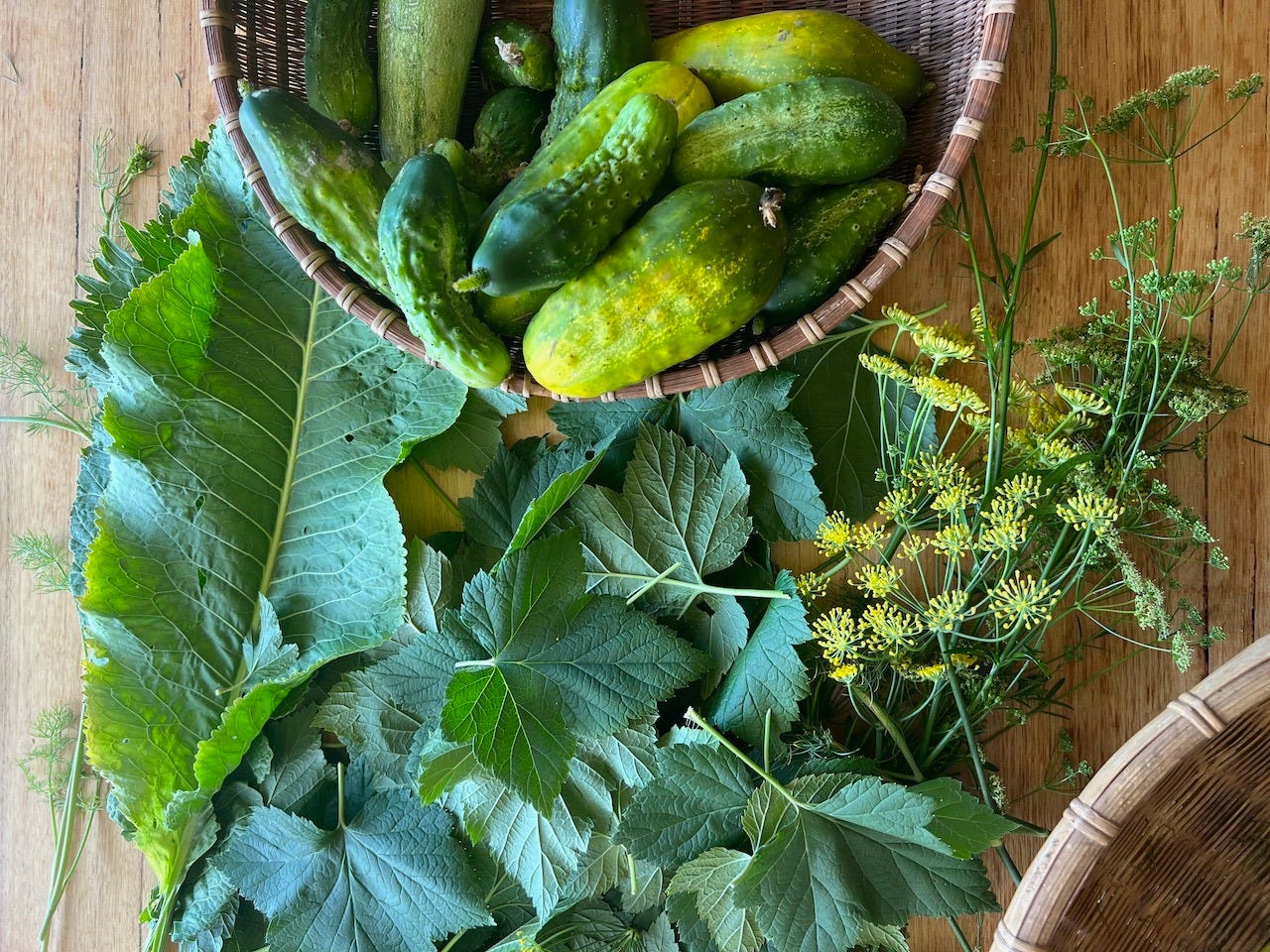
I’m not sure if this process would work for all lacto-ferments, but it does work for national pickler cucumbers. Very well.
Basically this progressive pickle is a process of making up a huge vat of pickle brine, then adding the cucumbers as they ripen, plop plop plop. This process seems to work best if:
The brine is salty enough to really do a good job
The cucumbers go in freshly picked (after cleaning)
You pay attention and check it daily (which is fairly easy if you are adding cukes daily)
Get yourself a large fermentation crock, or bucket, and get it clean as a whistle. We use 20L clay fermentation crocks for this, but use whatever you have to work with - jars, buckets - even a big non-reactive cooking pot will do.
My fave cucumber pickle method is the ‘sour pickle’ - introduced to me by the lovely Sandor Katz, when we brought him to Australia to do a round of fermentation workshops (god that was a fun time) back in the day.
Gather your first few rounds of cucumbers, keeping them in the fridge until you have 10-ish to get started with.
To keep the pickles crunchy, you need some tannin in the mix. Leaves with enough tannins to be helpful include grape vine leaves, horseradish leaves, black currant leaves, oak leaves, or a big pinch of green tea will do the trick also.

I gather a big bunch of blackcurrant leaves, as they’re closest to hand, and source some local garlic (we ate all ours) to go in there too. There’s a few bits of dill growing here and there amongst the tomatoes, so I grab those, and some dill seeds from last years harvest.
Everything gets washed, then the tannin-rich leaves go in the bottom of the crock (a few big handfuls, don’t scrimp) followed by whole heads of garlic cut crossways.
Wash your cucumbers and remove any evidence of the flower end. The more uniform in size you can pick the cukes, the better. If there’s a few big ones, throw them in anyway - they’ll just take a bit longer.
Once the cucumbers are prepped, they go in ontop of the leaves, dill and garlic.
Put some more tannin-y leaves ontop - these can really help keep everything submerged and in place, so the bigger the leaves, the better - I use horseradish leaves for the top layer for this reason.
Next - important - put a weight on it all. An upside down plate works well (maybe two?), or a series of clean flat rocks with a cloth under them, or fermentation weights if you have them.
Then, it’s brine time. Sandor says 5.4% brine for sour dill pickles, and he knows things. So 5.4% brine it is.
I’d recommend against spoonfuls and floating eggs and all the very sort-of-accurate measures for how much salt to use. Accurate salt means good brine. And when you’ve spent 6 weeks stewarding your crock of baby pickle dreams - getting the brine wrong, and having the pickles be inedible, would be a sad thing.
So. measuring time. A 5.4% brine is made by adding 54g of salt to 1 litre of water. Pretty straightforward. Multiply as needed, for more litres.
Use the best quality salt you can find - either rock or sea salt is fine - no caking agents or iodine, if you can manage it. Weigh up 54g, add it to a litre container, add a bit of hot water to dissolve the salt, then fill it up to the litre mark with cold water and stir until it’s all dissolved. Hooray for brine.

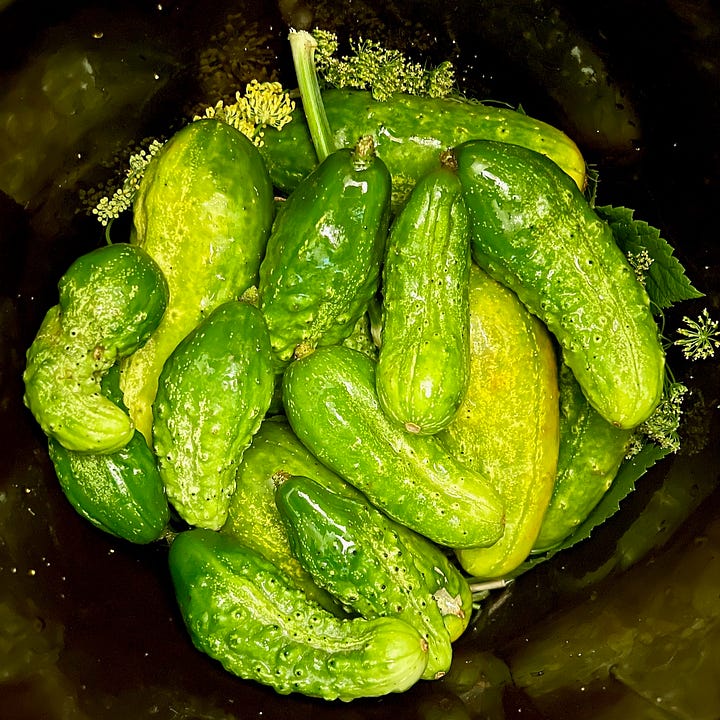
In a progressive pickle, I’ve found the best way to add the brine is all at once, at the start.
This means that the first cucumbers added ferment more slowly (due to all that salty brine) and then as you keep adding cukes, the brine-to-pickle ratio evens up somewhat, and the lacto-bacillius really brew up and do their fermenty thing - which means the later-added cucumbers ferment a bit faster. It evens out pretty well, by the end.
So for a 20L crock, I’ll make up 10L of 5.4% brine, and pour that over the little arrangement of cucumbers way down on the bottom - who are covered by leaves, and their weight.
And then tomorrow, or the next day, as I pick a few more cucumbers, in they go - washed and ready to join the pickle party.
For the first few additions, it can be a bit tricky to add more pickles without having them all bob up to the surface, because of all that brine. If I’m just adding a few, I can tuck them under the leaves and the weight without too much trouble. If I’m adding a lot at once, I’ll sometime add another plate ontop of the new layer, so everything stays where I want it.
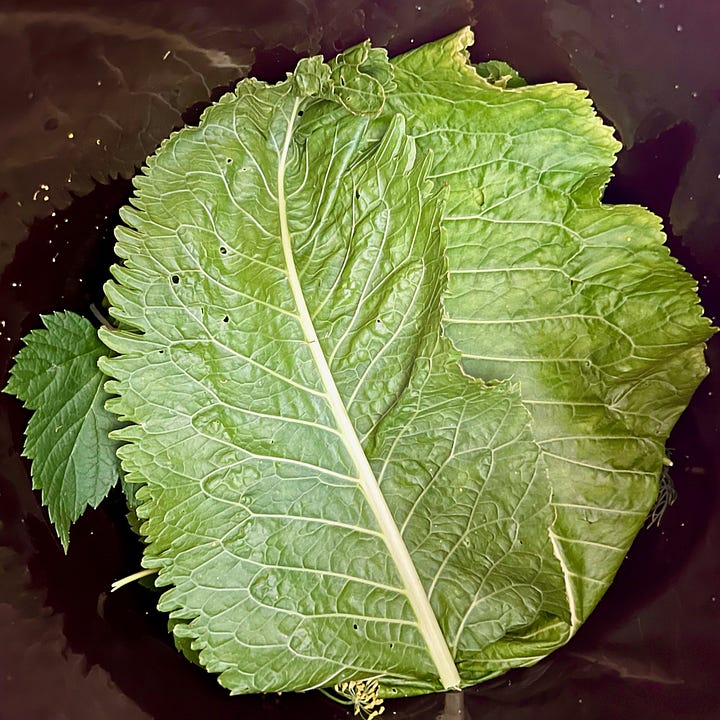
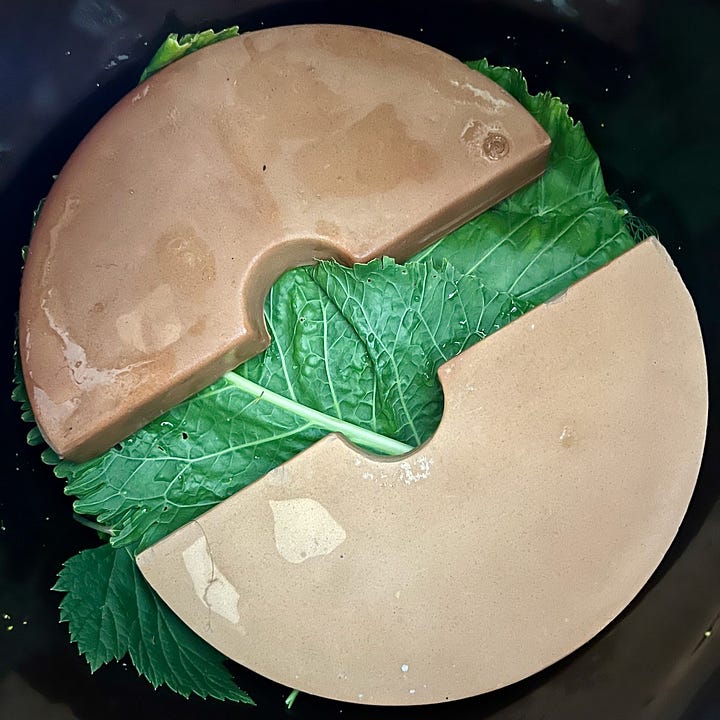
The main rule is - if it’s all under the brine, it will be fine - so always have more brine than you need in there, to ensure that everything is well submerged.
And so it goes, for the next 4 weeks or so, while the cucumbers are in season. By the second quarter of the next moon, I’ll stop adding cucumbers to this crock. And once they’re all in there, I’ll leave it another week, then taste, and bottle when it’s ready.
For most lacto-ferments, I let them ferment on my kitchen bench, so that they’re in an ambient, roomish temperature.
With these progressive pickles, I’m after somewhere a bit cooler - which slows the fermentation process a little, without slowing it down too much.
At this time of year, that spot is outside our front door, in the all-day shade. About 5 degrees colder than room temp, but not fridge-cold. Perfect.
Also, fermentation (for me, anyway) is as much about noticing, habits and choosing a spot where you will definitely check in on the fermenting thing, very regularly. Which is why the kitchen bench works so well - it’s right in your face, every time you make a cuppa.
Outside the front door is another good spot. I’m passing there all the time, it’s easy to get to, and not in the rain. Therefore, my brain says, it’s perfectly doable to go to this spot every day to add a few more cucumbers, and to check on things.
Having ruined many a crock of slow-fermenting hope by stashing it somewhere a bit too far out of the way for my daily patterns, I have learned this lesson the hard way.
My optimism of ‘I will definitely go down to that obscure spot in the garden every morning to check on it no matter what life throws at me each day’ is not to be listened to, I have found. I must put it on the bench. Or in the hallway. Or by the front door.

Pickles are particularly important in our house these days, as I’ve needed to re-imagine what care looks like.
In the last few years, how things like meals and food work in our house has changed quite drastically. There’s a lot to explain, and some of it’s not my story to tell, so by way of contrast…
Three years ago, we ate every meal together, as a family. While we had likes and dislikes, I mostly cooked from the garden, seasonally, and what was on your plate was what you ate, and you stayed at the table until that had happened. The food was nourishing, wholesome, and made with love. It was also my imagined version of what best-practice care looked like - based on my influences, my upbringing, and how I felt a family ‘should’ spend time together, if they were to remain unbroken as a unit.
Also - if you didn’t show up at the table for dinner every night and be chatty and sprightly, then you categorically Did Not Care. And I would take that personally, because my own wounds assumed that this was so.
Cheese toasties, posted through the door of my teen’s bedroom with a simple murmured ‘I love you’ from me, each and every night for months at a time, was not on my radar as a form of care - neither in the giving, or the being able to ask for.
However. In the last three years, this household has been on a whirlwind journey of discovery, care, mental health, un-masking, and truth-telling, such as we can each articulate. Things have changed.
I now know that, for my kid, caring looks very different to insisting that they sit down for dinner and Talk To Me at the alotted time that has been allocated to us as a family, culturally. I have learned that safe foods (hello, cheese toastie) can soothe, and make many things better, even those things that are very very hard to keep living with, and through.
I have learned that insisting that we do things in the Family Way, for no other reason than the fact that I’d absorbed that to NOT do things that way signalled failure, or harm, or shame, or Not Caring - was something I needed to let go of.
Care can look like chats and a snack together, when it’s a good day, and warming safe-foods, in the quiet of your bedroom, with minimal words exchanged (and maybe an extra pickle), when it’s not a good day.
Care can look like learning to pay close attention to what is actually doable for this kid, this day, rather than assuming I know better, and pushing them too far.
Family time can look like whatever it needs to - far away from the sit-down wholesome dinner - and instead, a cuddle on the couch and a joke shared - if that’s where everyone is at, that day. Care is adapting, to keep everyone intact. Care is tending to my own sadness gently, when days are hard, and being ready for tomorrow to be better. Perhaps.
I know that next year, our daily setup might look like something else again. Family time might look entirely different, as things change.
And if we’re all back at the table one day, because that works for everyone, then - great.
But I’ve come to learn that what really matters is that I continue to figure out how to listen, and show up - based on what is needed, rather than what is assumed. For those that I love. And for myself, also.

All this has been a great (as in immense, as opposed to fun) time of learning. And it has affected what I cook, what I spend time on, what I focus on growing in the garden, and what I do not.
But I’m damned if I’m going to stop fermenting entirely. Because it is SO FUN and also GOOD FOR YOU.
Luckily, cucumber pickles are firmly on the yes-please list, at our house. Everyone eats them, gladly. On toasties, on snack-plates, beside noodles, or on their own.
And so, my kitchen staples - the wholesome, made-with-love basics that I make from scratch, in quantity, and try to have around all through the year - are changing. We prettymuch run this house on large jars of toastie sauce (full of garlic, herbs and tomatoes, I’ll show you another time), and pickles.
Eggs are swapped for a big loaf of sourdough on a Tuesday, with our local CSA bakery. I do not make the cheese for the toasties at the moment, although I’ve done that a lot in the past, and that’s fine with me.
But I do try to make the pickles, if I can. We always run out by next spring, but that’s still 3 seasons of lacto-fermented wonderment I can get into my family each year, so that’s a win that I hold onto.
And so, the slow progress of the pickle continues - as a fundamental form of care, in our current household setup.
I am glad to have the help of this species, Cucumis sativus, to learn more about biding time, picking things when they are ready, and adapting recipes (and world views) to what is needed - in order to keep caring for each other, according to what each season requires of us.
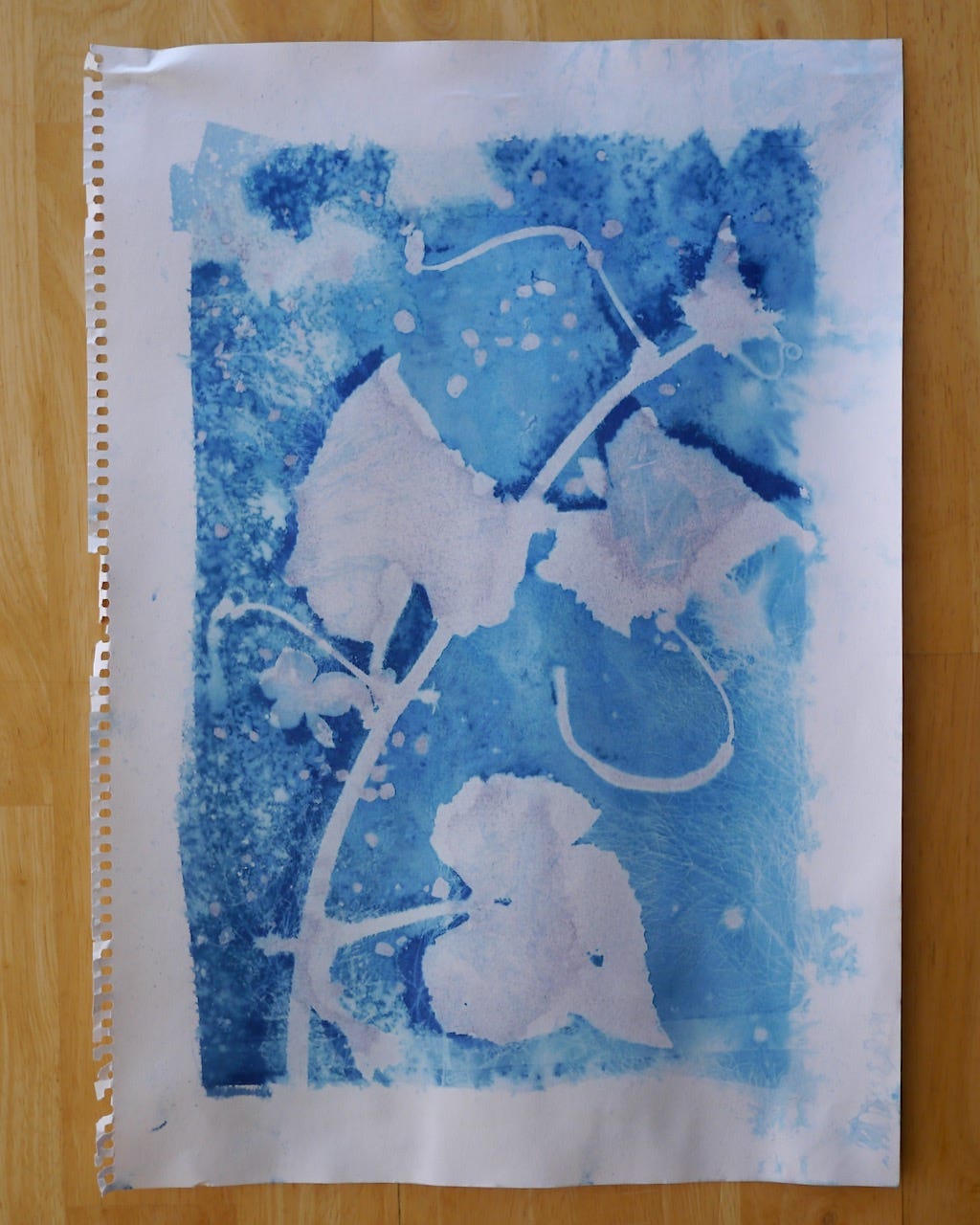
Thanks to Eggplantia for her great conversations about re-imagining what family care can look like with neurodiverse kids, which really helped me along - love you, lady x


The moon, pickles and neurodiverse teenagers, just the sort of magic I needed today. So glad to have your soulful writing on Substack. Sending you some love and gratitude.